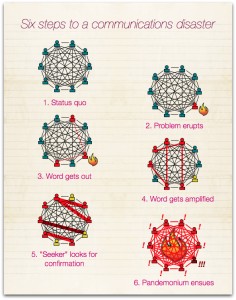Further to my post yesterday about communications paths, I thought I’d reuse my crappy diagram to demonstrate another point about communications on projects: news flows like water.
On any project with more than a small handful of people, word travels fast. While it might move fast, however, it’s rarely accurate. In all my years on projects, I have consistently observed a tendency for people to rapidly amplify and distort news, thus creating artificial problems for a project manager to contend with. I would be interested in reading any studies that empirically show the phenomenon I am about to describe.
Let’s review my new crappy diagram above:
1) Here’s a team of 10 project members, all happily doing their thing. Life is serene and beautiful.
2) A problem erupts. Something bad happens in one team member’s workspace. Doesn’t matter what it is, or how big or small. The point is, that person isn’t happy.
3) At the water cooler or the smoking area, the victim gets the word out. Hopefully they’ve let you know about the problem too, and you’re on your way to help solve it. However, in this drawing, two other people are now aware. The original victim’s agitation alarms the new people.
At this point, you have two problems whether you know it or not. There’s the “bad thing” that happened, that still needs to be dealt with, but now bad news has gone out into the world. You don’t yet have control of that news.
4) Hooray! You put out the fire. The “bad thing” has been resolved, but the person it happened to is still pretty sensitive. The two people they told however, are still alarmed, and have each told two other people. Here’s the quirky thing about people: when alarmed, they have a tendency to amplify the severity of news to justify their alarmed state.
5) By now the victim of the “bad thing” has had a chance to let people know that the fire is out. These people are calmer now, but just like the first victim, still sensitive. At the same time, the newer people on the chain are continuing the amplification trend. Sooner or later, someone with some clout is going to seek confirmation.
6) If you haven’t yet taken steps to quell the news across the whole project, someone will get back to the original victim. The victim’s sensitive state will do more to confirm the news’ amplified severity than anything the victim says. This threatens to light the whole communications web on fire.
Getting ahead of these fires is a job every project manager should plan for from the start of each project. Individually, the small fires that start here and there around the project generally have specific solutions. The larger fires that spawn as a result of gossip however, are much more dangerous. Because the climate of the project is inextricably linked to the project manager, communication fires like the one painted here spell extra trouble for you.
We’ll talk more about how to get ahead of these fires and keep them quelled tomorrow.
Ultimately, you want to avoid hearing, “who’s responsible for this mess anyway?”

